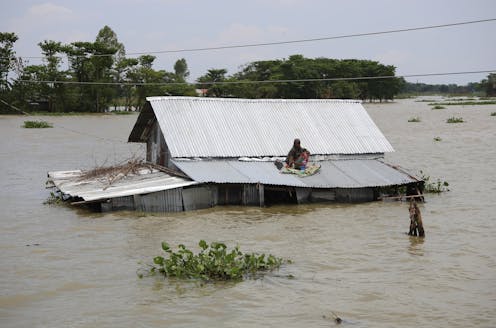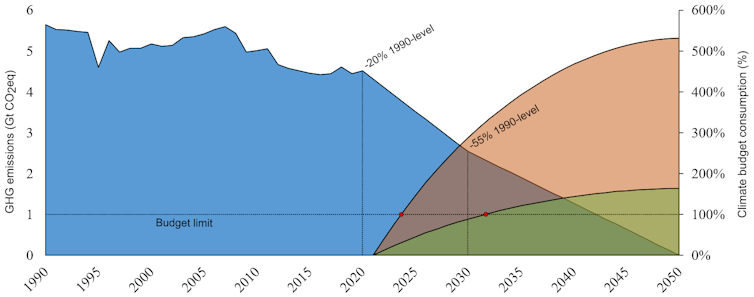
Last week, Azerbaijan hosted the United Nations Convention on Climate Change, also known as COP29. Its main objectives were to agree on a financial framework for climate change mitigation and adaptation, and to present national plans for meeting the terms of the Paris Agreement. This includes limiting global heating to 1.5C, a limit that we have, though temporarily, already passed.
Though the credibility of these annual gatherings is fading, multi-million dollar agreements are essential to accelerating urgently needed climate mitigation measures. A great many people are already suffering the consequences of climate intertia: millions of climate refugees, embattled sectors of the economy, and the population of the Valencian Community in Spain, to name a few.
Leer más: Valencia floods: Our warming climate is making once-rare weather more common, and more destructive
Climate justice for the most vulnerable
The +1.5C and +2C limits reflect ecological tipping points that, if exceeded, could trigger irreversible consequences on a global scale.
As we approach these tipping points, the social impacts of climate change multiply and worsen, prompting calls to address climate change from a climate justice perspective, which takes into account the different responsibilities for the problem, as well as the unequal impact it generates.
A perverse inequality unerpins the climate fight. Those who contribute most to the problem – who have benefited most from it and have the most scope for action to curb it – suffer the least from its negative consequences, and therefore have the least incentive to solve it. Conversely, those who are most vulnerable to the effects of climate change have the least capacity, either to mitigate or adapt to them.
While we debate ecological thresholds, many regions of the planet – and their inhabitants – are already undergoing irreversible transformations.
The EU’s role
The European Union (EU) has positioned itself as a key player in the climate fight. Its climate policy aims to reduce net emissions (relative to 1990) by 55% by 2030, and to be carbon neutral by 2050.
Additionally, the EU, its Member States and the European Investment Bank are, in combination, the world’s largest contributors to climate financing – they expect to raise $100 billion in 2025 alone.
However, not all that glitters is gold. In our recent study – pending publication in the journal Mitigation and adaptation strategies for global change – we assessed the EU’s climate responsibility to decide whether its policies meet the criteria of climate justice. We have concluded that the EU’s efforts lag far behind their responsibilities.
To reach this conclusion, we used the global remaining climate budget – the amount of greenhouse gases (GHGs) that can be emitted before a limit is exceeded – to estimate what the EU would be entitled to on a per capita distributional basis.
We have also reconstructed the EU’s historical (1850-2050) emissions, using available data and EU climate policy projections.
To do this, we assessed the EU’s greenhouse gas (GHG) reduction targets in ten different scenarios. These start from five different base years to begin computing the EU’s carbon budget: 1850 (since Western European industrialisation), 1990, 2000, 2015 (since the Paris Agreement) and 2021 (without considering past emissions). For each of these periods, the carbon budget has been estimated taking into account two limits: +1.5C and +2C.
In general, the further back we start our calculations, the higher the EU’s share of responsibility in the overall budget, and the higher its consumption of the budget allocated in 2020. This can be explained by the EU’s high level of GHG emissions between 1850 and 2020 compared to other regions of the world – the EU only accounted for 8% of the world’s population between 1950 and 2020, but emitted 22% of all net GHG emissions (based on consumption) in this period.
Our results show that in seven scenarios, the EU has already used up its budget, and in the other three it will do so in the next few years. In the most favourable scenario – limiting warming to +2C without considering pre-2021 emissions – the EU will have used up almost double its climate budget by 2050. In the most unfavourable – limiting warming to +1.5C without considering pre-2021 emissions – it has already used its budget more than five times over. These are all in the hypothetical case of actually reaching carbon neutrality in 2050.

This has two immediate implications. Firstly, European climate policy – probably the most ambitious on the planet – is not designed to meet the global climate budget. If even the most advanced climate policy does not take its share of the global budget, we will struggle to limit global heating to 1.5C or 2C.
Secondly, the EU going over its budget means that its policy is not built on principles of climate justice, and engages in behaviour that could be considered abusive towards the communities most affected by climate change. Other academics have highlighted this as a new and ongoing form of colonial inequality.
Climate justice for COP29
Other countries – such as the US, Russia, Canada and the UK – are also over their climate budget. Their prosperity has come at a cost, and created a problem that now affects everyone. Beyond its planetary impacts, climate change affects people and is, fundamentally, a social issue. If we do not make this social dimension a central point of debate, we will struggle to enact policies that account for climate justice.
Two ideas can help integrate climate justice into COP29. First, we need to impose more ambitious targets that consider not just ecological limits, but also the uneven impacts of climate change. Second, the nations of the Global North have emitted disproportionate amounts of GHGs since the Industrial Revolution. States with the highest climate debt have a moral obligation to finance global climate action, both in terms of mitigation and adaptation.
We therefore urge COP participants to bear in mind the principle of “common but differentiated responsibilities” promoted by the United Nations Framework Convention on Climate Change, and to act accordingly.
Brais Suárez Eiroa receive funding from Xunta de Galicia (ED481B-2023-011)
David Soto-Oñate receives funding from the Spanish State Research Agency (Ref: TED2021-131826A-I00).
This article was originally published on The Conversation. Read the original article.







